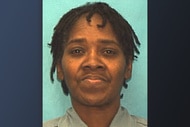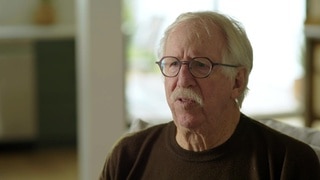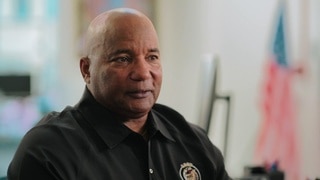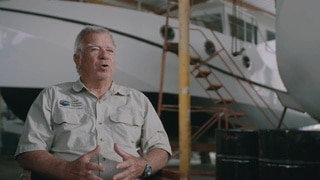Create a free profile to get unlimited access to exclusive videos, breaking news, sweepstakes, and more!
16-Year-Old Girl Murdered, Then Thrown Off Plane into the Ocean: "Nightmarish Scene"
There was more than one suspect over who purportedly dropped the body of 16-year-old Kimberly Holton out of a flying plane and into the New Jersey waters.
Authorities in two states worked together to learn what happened to a teenage Jane Doe whose body was discovered in the Atlantic Ocean.
On October 8, 2003, fishermen spotted what they believed was debris about three to four miles from the shores of Cape May, New Jersey. Upon closer inspection, the couple realized they’d found what now-retired New Jersey State Police (N.J.S.P.) Detective Steve Brown called a “severely decomposed” body floating in the sea with no signs of identification.
N.J.S.P. Crime Scene Investigator James Thistle told Deadly Waters with Captain Lee that a rock crab “gnawing at her inner thigh” told investigators about where the body had been.
“Rock crabs are bottom feeders, so investigators know that at some point, the body did sink to the ocean floor,” explained show host Captain Lee.
Because the unknown female’s body was beyond two miles from the Jersey Shore, the United States Coast Guard (U.S.C.G.) helped State Police examine the body. All presumed the victim met with foul play based on a large metal chain wrapped around the victim’s ankles and duct tape around her feet and hands.
For more on true crime:
Illinois Father Is Shot Dead When Picking Up Daughter From Ex-Wife's "Clannish" Family
Clues Revealed for First Time in Murder of 27-Year-Old Singer Found Tied Up in Her Home
The Shocking Murder of NBA Star Lorenzen Wright: "Ultimate Evil"
It was thought that whoever disposed of the body didn’t anticipate that she’d float to the surface. So far, according to Thistle, the body was their “only clue,” and so making an identification was crucial.
Thistle said the Jane Doe’s fingerprints were so “pruned up” on account of being in the water that traditional methods of finding a print could not be used.
“I basically took some saline solution and took a hypodermic needle,” Thistle explained. “I tied a string around the last knuckle of the finger, and I was able to inject [the] saline solution under that finger pad and then roll it and get an identifiable fingerprint."
The Jane Doe was ID’d as 16-year-old Kimberly Holton, a missing foster child out of Dover, Delaware, about 40 miles directly northeast of Cape May.
About Kimberly Holton’s disappearance
Holton’s best friend, Destinee Andrews, told Deadly Waters they met on the school bus while in high school, citing Holton as “the sweetest person you’d ever meet.” The friend said Holton lived with her foster family, the Machettes, as well as a foster sister, Heather.
“Kim absolutely loved animals; I do believe she would have been some type of vet or vet tech,” Andrews said. “She helped animals because nobody helped her when she needed help.”
But Andrews believed Holton’s “bubbly” personality was a way of hiding her past, which was rife with turmoil. According to Holton’s first foster mother, Sherry Welsh of Williamstown, New Jersey, the child’s early life consisted of having little food and no toys, which laid the groundwork for why children’s services had to intervene.
It seemed her troubles only grew after Holton began living with the Machette family, and when she missed the school bus on September 30, 2003 — eight days before Holton’s body was discovered — Andrews knew something was “terribly wrong.”
That day, Holton’s foster mother, Lorraine Machette, reported the teen missing. State Police in New Jersey, tasked with investigating after the body was found in the water, teamed up with the Delaware State Police (D.S.P.) to learn more about the child’s background.
“Lorraine described that Kimberly had gone missing in the past,” Det. Brown told Deadly Waters. “She would run away, gone for a couple [of] days, and would come back, so it seemed to me that there were a lot of issues within that household prior to Kimberly going missing.”
How did Kimberly Holton die?
Detectives assigned to the case found no apparent signs of trauma that could explain why Holton died. However, a medical examiner stated she’d sustained severe blunt force trauma to the head, the result of falling from a “significant height,” Investigator Thistle said.
The strongest piece of physical evidence they had was the chain that bound the victim’s ankles.
Thistle observed each link of the metal coil chain contained stamped numbers, which led detectives to a specific Lowe’s home improvement store not far from Holton’s residence.
“During the course of the interview with the manager of that Lowe’s in Dover, he was able to backtrack through the computer system that same length of chain, that same stamp was purchased at that location,” said Det. Brown. “Along with clamps, clamps to the chain that was found on Kimberly’s body, and also cinder blocks.”
The purchase occurred just one day after Holton’s disappearance.
A time stamp on the receipt helped authorities quickly locate surveillance video of the transaction, which showed two males. However, because the video was grainy, and since the items were purchased with cash, detectives sought out local press to release still shots of the unknown persons in hopes that the public could help.
Detective Porter told Deadly Waters they were “flooded” with phone calls, with multiple tipsters pointing to Robert Brothers. Brothers himself called the tip line, admitting he was with one Jacob Jones when the latter purchased the chain.
What police learned about Jacob Jones
Brothers admitted to being at Lowe’s but denied taking part in a crime, as seen in a videotaped police confession obtained by Deadly Waters. He said Jones opted to buy the items for the purposes of weightlifting.
“It did not strike me as odd whatsoever,” Brothers told police. “All I know is what he’s told me. There was no conversation that came up where it had to deal with it being used for something criminal, harm, or anything like that.”
Police found no reason for Brothers to lie, and when they asked him to guess why Jones might have had it out for Holton, Brothers said, “Heather,” the victim’s foster sister.
Heather was also the girlfriend of Jacob Jones.
“I do believe that there was a lot of tension between Heather and Kim,” Andrews said of her childhood friend. “Kimberly was beautiful. Heather could have possibly been jealous of the way Kim looked.”
When brought in for questioning, a sobbing Heather admitted that she and Holton got into typical sisterly rows, such as borrowing clothes without permission. Otherwise, she had no reason to hurt Holton.
“I swear to God, I don’t know what happened to Kim,” Heather cried to investigators. “I don’t know if Jacob had anything to do with this. I don’t know nothing about this. All I know is I am completely innocent.”
Jacob Jones was a 20-year-old sophomore who studied at the University of Delaware. He was an unlikely murder suspect, as he had no criminal background and held a 4.0 G.P.A. According to peporter Jeff Brown of The Dover Post, Jones was enrolled in the aeronautical program and a licensed pilot and instructor at the Dover Air Force Base, where he was certified to use planes and regularly chartered them.
In interviews with police, Jones admitted to buying the chains, locks, and cinder blocks, but insisted it was for weightlifting. Police, however, didn’t buy it, especially since he could not account for where the items were then.
As captured on video, Jones didn’t veer from his story and soon requested an attorney.
“We spoke to his supervisor, and the supervisor said that over the course of the last few weeks, Jacob stopped showing up for work, or he was late,” said Det. Brown. “He was very agitated and angry."
Records showed that Jones took out a Cessna plane on Sept. 30, 2003, at 11:45 p.m., and returned it two hours later. Police deduced a second person would have been involved to at least help Jones move Holton’s body and restraints onto the plane before someone dropped it from the sky and into the ocean.
Investigators gleaned that the severe injuries to Holton’s head were inflicted post-mortem from the fall.
A second suspect comes into the picture in Kimberly Holton's murder
On Oct. 23, 2003, — 10 days after Holton’s body was discovered — Jones’ father called authorities and said Jacob Jones died of a self-inflicted shotgun wound in his bedroom. Moments before the suspect took his own life, however, he confessed to his parents that he and 23-year-old acquaintance Michael Keyser killed Kimberly Holton.
According to Det. Brown, Jones told his father that Holton “was causing issues in the family home, especially with his girlfriend, Heather,” and that he was compelled to “rectify the situation.” He was assisted by Keyser, who worked with Jones as a security guard at the local racetrack.
“Jones and Keyser had known each other, but peripherally,” said The Dover Post’s Jeff Brown. “They didn’t hang out together. They apparently didn’t have a whole lot of common interests other than their one job.”
Police eventually questioned Keyser. According to him, Jones asked Keyser to pick Holton up on the night of Sept. 29, 2003. Keyser and Holton went to a local Wawa convenience store and, upon Jones’s request, Keyser took the girl to a Budget Inn motel where Jones and Holton could purportedly discuss the issues with Heather.
At one point, Holton went to use the bathroom.
“Jake tells me he wanted to kill her, and he wanted me to help him kill her and dispose of the body,” Keyser told investigators. “I told him he was nuts; I didn’t want no part of it; I wanted to leave. He told me basically that if I didn’t help him, he would kill me.”
Keyser said that, per Jones’s instructions, he helped grab Holton once she exited the bathroom and held her legs down while Jones wrapped a phone cord around the teen’s neck and smothered her to death with a pillow. He placed the time of death somewhere around 2:00 a.m. on Sept. 30, 2003.
“She stopped moving, she stopped kicking,” Keyser continued. “I just sat there, and he felt her pulse. She was dead.”
Keyser confessed to helping Jones move Holton’s body into his trunk, where the body was believed to have been left for hours until Jones — and possibly Keyser — loaded the body onto the plane in Cheswold, Delaware, and dumped her body into the Atlantic.
“It’s just a nightmarish scene,” said Det Porter.
What happened in the case?
On Oct. 24, 2003, police announced Michael Keyser’s arrest. According to Deadly Waters’ Captain Lee, Holton’s disappearance could have been passed off as a teen running away, but Jones failed to consider the elements of the ocean.
“The plane was at such a high altitude, when Kimberly’s body hit the water, it acted like it hit concrete at 130 miles an hour, and the cinder blocks disintegrated upon impact,” said Captain Lee. “This lack of knowledge, on his part, allowed the truth to rise to the surface, along with Kimberly.”
On January 6, 2004, Keyser was found guilty of first-degree murder and conspiracy and sentenced to life behind bars.
Kimberly Holton’s foster sister, Heather, was not charged in connection with the crime.
Watch all-new episodes of Deadly Waters with Captain Lee, airing Saturdays at 9/8c on Oxygen.




































